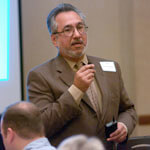
San Antonio (April 13, 2004) – Allied health professions students, who are critical future members of the health care team and have the potential to improve our nation’s response to acts of bioterrorism, natural disasters and other public health emergencies, are expected to benefit from training materials under development through “Texas C.A.R.E.s,” a statewide program coordinated by The University of Texas Health Science Center at San Antonio. C.A.R.E.s stands for “Curriculum for Allied Health Response to Emergencies.”
At a meeting in San Antonio this spring, Texas C.A.R.E.s participants from the Health Science Center, Dallas, Amarillo and Laredo adopted guidelines to develop training materials for allied health students in two-year, four-year and master’s degree programs. Texas C.A.R.E.s also will target high school students from a health science magnet program in Laredo and border health volunteers known as “promotoras.”
The Health Science Center is administering a two-year, $1.1 million bioterrorism curriculum development grant from the U.S. Health Resources and Services Administration. Marilyn Harrington, Ph.D., dean of the Health Science Center’s School of Allied Health Sciences, is the principal investigator. She enlisted the collaboration of the UT Southwestern Medical Center at Dallas, UT Dallas, Amarillo College, the Health Science Magnet Program at Alexander High School in Laredo, and the Texas A&M University Center for Housing and Urban Development’s Promotoras Program, Central Rio Grande Region.
“The grant program will result in educational materials to be used throughout Texas and a cadre of certified volunteers and allied health personnel who are prepared to respond to public health emergencies within their communities,” Dr. Harrington said. “A required activity of the curriculum will be participation in an emergency exercise in each partnering city.”
An executive advisory board is composed of representatives from the health and fire departments of each city, bioterrorism response planners from Texas Department of Health Public Health Regions 1 (Amarillo), 2/3 (Dallas) and 8 (San Antonio), a National Disaster Medical System area manager and other members. Laredo Health Department Director Hector Gonzalez, M.D., M.P.H., chairs the board.
A separate curriculum advisory board is composed of members from each of the partners. Allied health professionals who might assist in the event of a public health emergency include emergency medical technicians, physician assistants, respiratory therapists, clinical laboratory scientists, physical therapists, occupational therapists, dental hygienists and dental laboratory technologists. The Health Science Center trains the majority of the professionals practicing these skill sets in South Texas.
Texas C.A.R.E.s will reach students in 21 disciplines through the collaboration of allied health sciences schools. Other disciplines are clinical nutrition, health information, nuclear medicine technology, orthotics/prosthetics, pharmacy technology, radiation therapy, radiology, rehabilitation counseling and surgical technology.
The spring meeting began with keynote speaker Michael Murphy, director of the Metropolitan Medical Response System, Emergency Medical Services Authority of Oklahoma City. Murphy shared his experience from two Oklahoma tragedies, the bombing of the Alfred P. Murrah Federal Building in Oklahoma City on April 19, 1995, and a high-intensity tornado that devastated the state on May 3, 1999.
“His message was the potential danger and disruption to the emergency management system posed by health care professionals offering help when it wasn’t solicited or when they don’t have background knowledge of emergency and disaster management,” said Elaine L. Demps, program coordinator for Texas C.A.R.E.s. “For example, in the bombing of the Murrah Federal Building, a volunteer nurse died from head trauma received by going into the building. With proper training, however, health care providers can become useful and helpful volunteers; this is a focus of our grant.”

